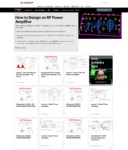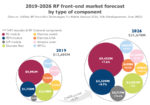The opening day at DAC was Monday and I had an appointment with Simon Rance (Cliosoft) and Stephen Slater, Product Manager of Keysight EDA in their suite. Back in February Daniel Nenni wrote about Keysight EDA acquiring Cliosoft, adding design data and IP management to their software offerings. I really wanted to hear how that … Read More
Transforming RF design with curated EDA experiences
Access to sophisticated RF EDA tools is one thing. Effectively harnessing their capability in real-world use is another. Digital EDA and test & measurement providers have long recognized ongoing customer education needs for their solutions. Keysight is embarking on an initiative to develop curated EDA experiences with… Read More
Keysight at #60DAC
Keysight EDA will have a large presence at this year’s DAC in San Francisco July 9-13. For a better understanding of what’s happening with Keysight EDA at DAC I talked to my contacts to learn that they have three main messages this year:
Demos: Booth 1531
You may recall that Keysight acquired Cliosoft… Read More
Advanced electro-thermal simulation sees deeper inside chips
Heat and semiconductor reliability exist in an inversely proportional relationship. Before the breaking point at the thermal junction temperature rating, every 10°C rise in steady-state temperature cuts predicted MOSFET life in half. Yet, heat densities rise as devices plunge into harsher environments like smartphones,… Read More
Keysight Expands EDA Software Portfolio with Cliosoft Acquisition
During the day I do M&A work inside the semiconductor ecosystem and I have been part of more than a dozen acquisitions during my career so I know a good one when I see it and I see a great one with Keysight and Cliosoft, absolutely.
Cliosoft came to SemiWiki 12 years ago when we first went online so I know them quite well. With more than… Read More
Big plans for state-of-the-art RF and microwave EDA
RF and microwave design is no longer confined to a few defense and aerospace EEs huddled in dark cubicles working with spreadsheets and primitive circuit simulators. Now, areas like 5G and automotive demand complex RF systems. Advanced RF and microwave EDA tools are taking on electromagnetic (EM), thermal, and power simulation,… Read More
Higher-order QAM and smarter workflows in VSA 2023
3GPP Release 17 and 802.11be (Wi-Fi 7) extend modulation complexity, raising the bar for conformance testing and test instrumentation to new levels. The latest release of Keysight PathWave 89600 Vector Signal Analysis 2023 (VSA 2023) software takes on higher-order QAM and smarter workflows, many customer-requested, for … Read More
Advanced EM simulations target conducted EMI and transients
A vital benefit of advanced EM simulations is their ability to take on complicated physical test setups, substituting far easier virtual tests yielding accurate results earlier during design activities. The latest release of Keysight PathWave ADS 2023 continues speeding up engineering workflows. Let’s look at three… Read More
Seeing 1/f noise more accurately
Electronics noise is often described as “white,” spread evenly across a band, typical on older semiconductor processes where thermal and shot noise dominate. As transistors shrink, “pink” 1/f noise takes over at low frequencies – becoming stronger in advanced processes and quantum computing technology. But it’s not an easy… Read More
Unlocking PA design with predictive DPD
Next up in this series on modulated signals is an example of multi-dimensional EM design challenges: RF power amplifiers (PAs). Digital pre-distortion (DPD) is a favorite technique for linearizing PA performance. Static effects are easy to model and correct, but PAs are notorious for interrelated dynamic effects spoiling … Read More










